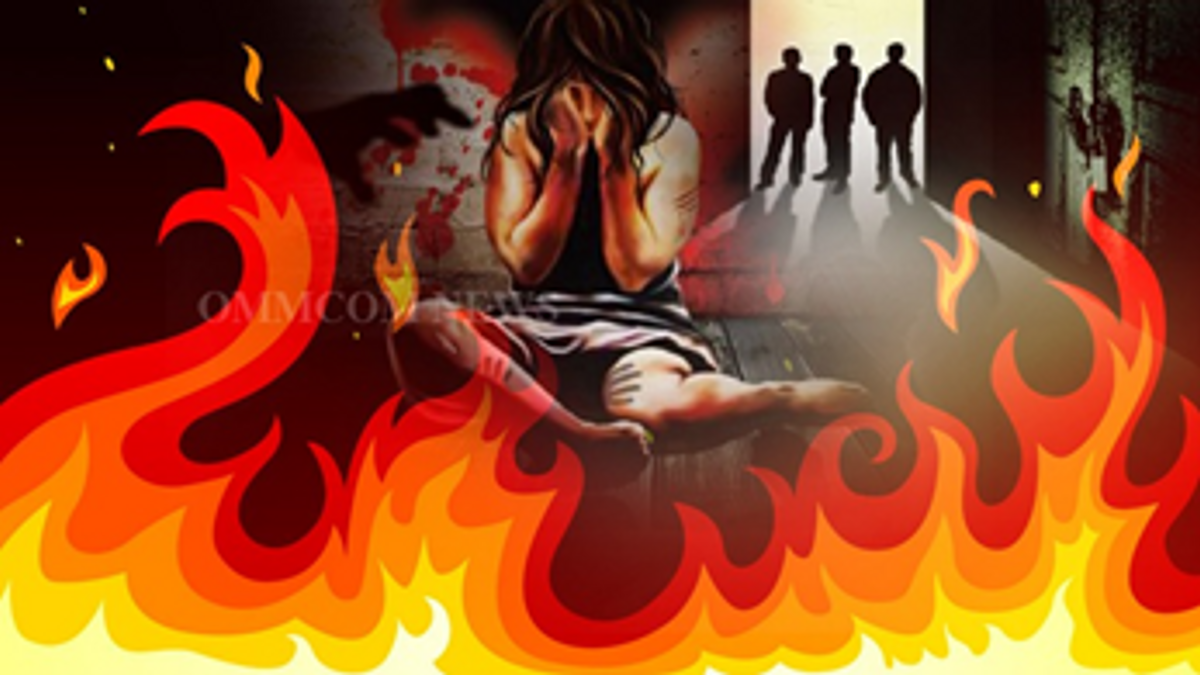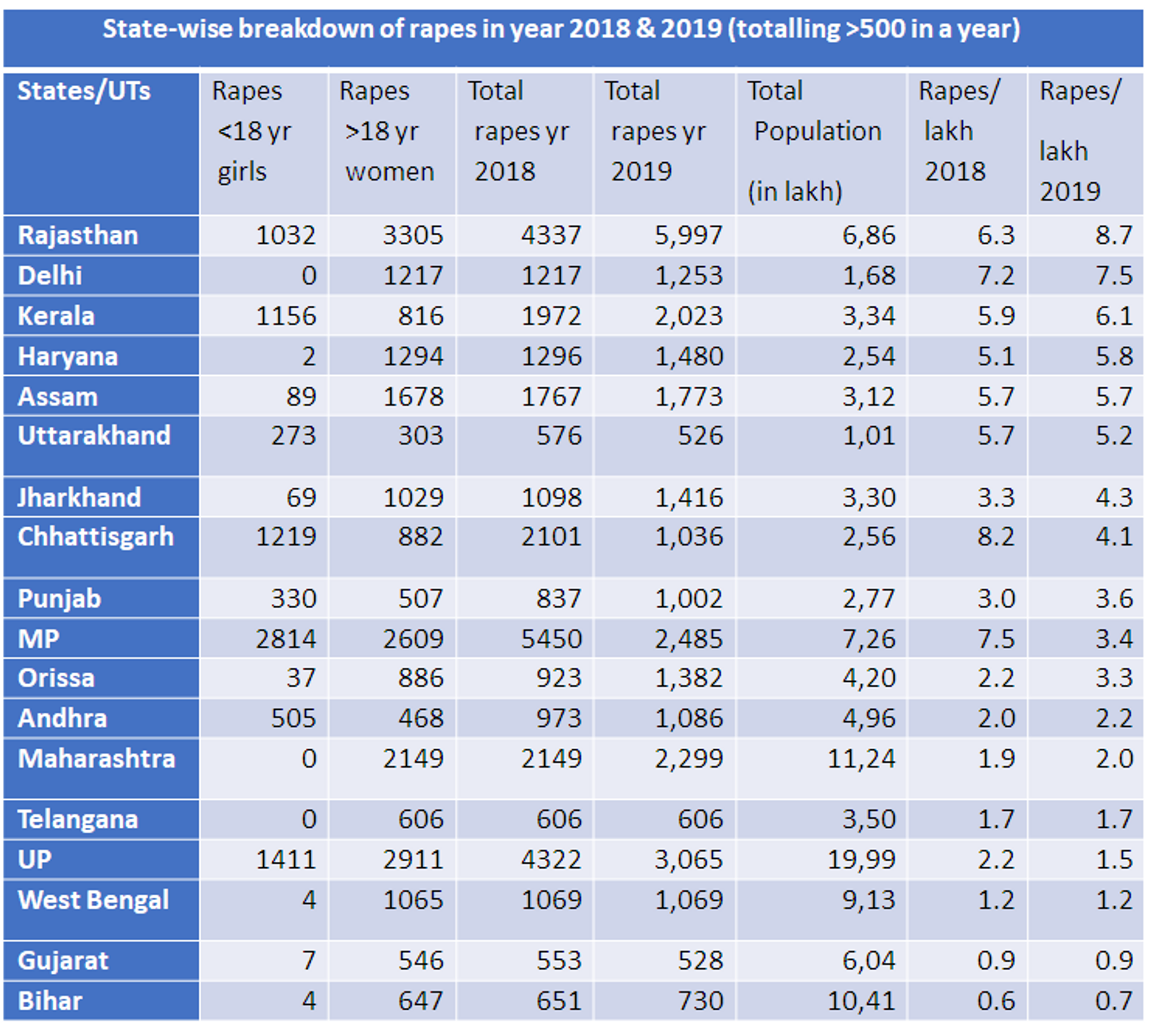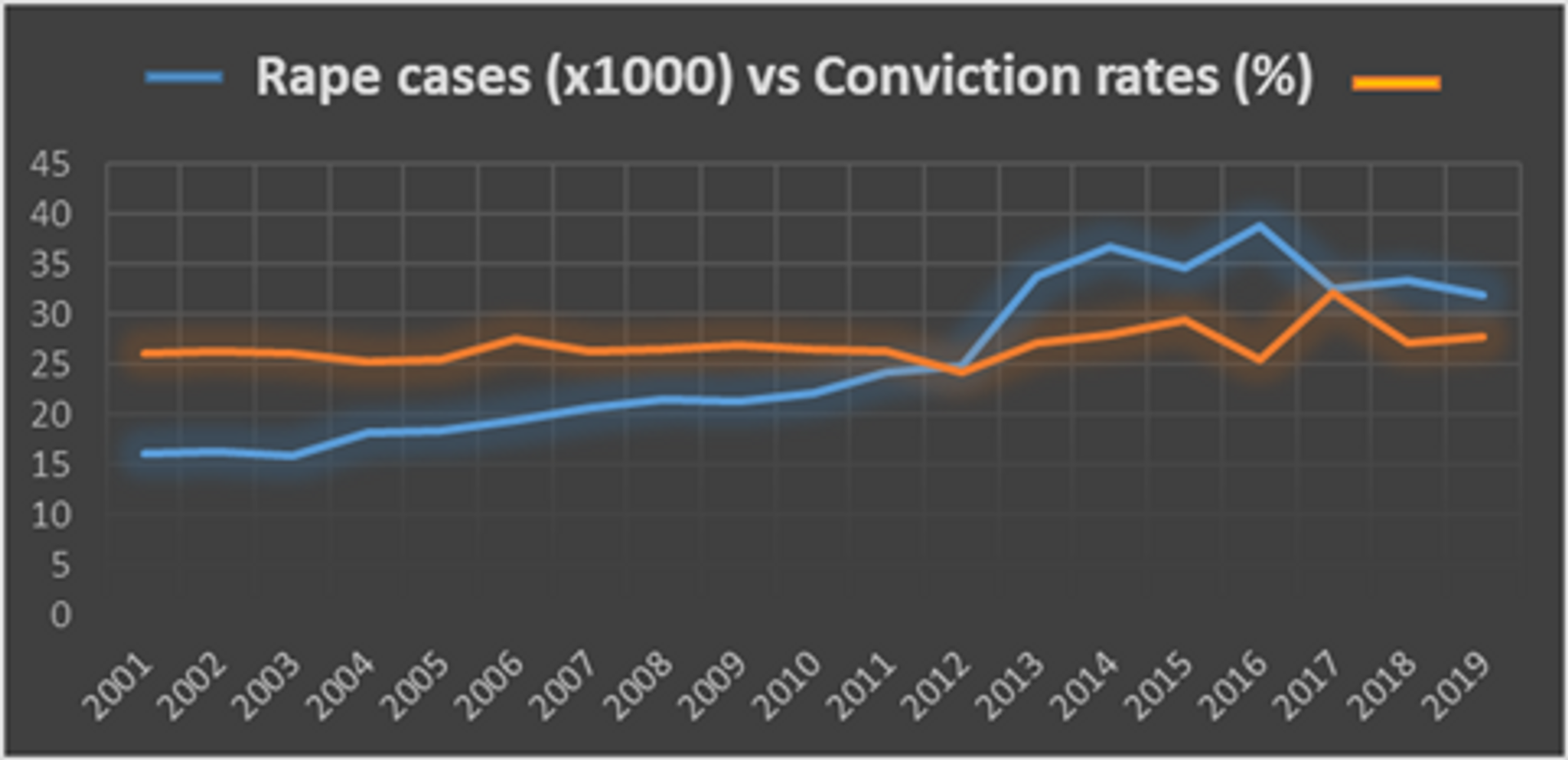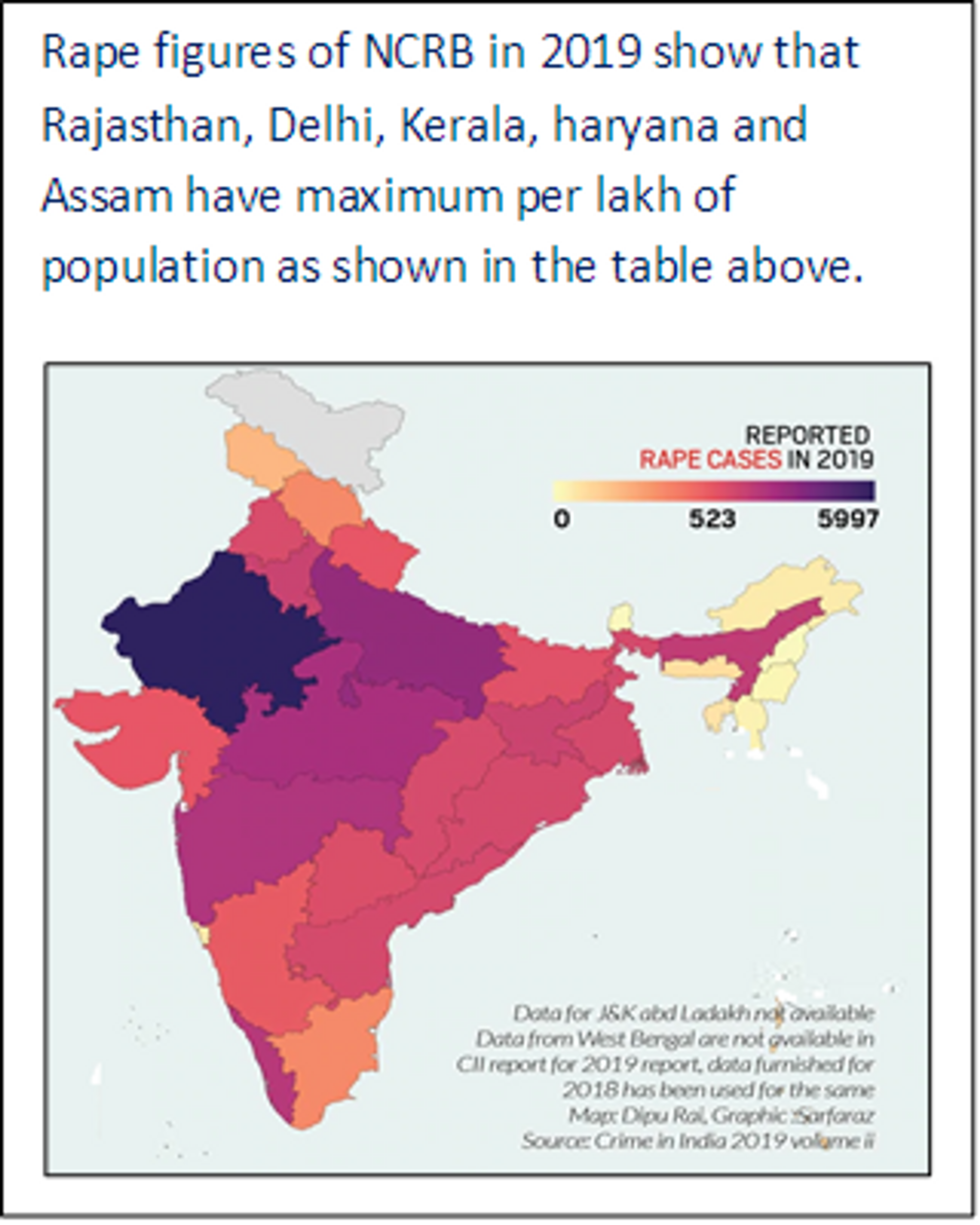
The Politics of Rapes in India
The rape is defined as ravishment of a woman without her consent or against her will by force, fear or fraud which is irrespective of the extent or the degree of penetration. A large number of women failed to report rapes to the police because they feared embarrassing and insensitive treatment by the doctors, the law enforcement personnel and/or the cross-examining defence attorneys. It used to be a general perception that more often than not, it was the victims rather than the perpetrators of rapes who were put on trials. The outcry of the Mathura custodial rape in 1972 was a watershed moment that made even apex court that passed a verdict in 1978 which created widespread outcry. The outcry against the near century old law on rape culminated into the Criminal Law (Second Amendment) Act of 1983. A new Section 114A in the Indian Evidence Act of 1872 was inserted which presumed “there is absence of consent in certain prosecutions of rape if the victim says so”. This applied to especially to custodial rape cases. There were few more tinkering of the law against rape in 1980s & 2002 too which tried to get rid of the cross-questioning of the victims ‘apparent immoral character’ but these could not change the general perception mentioned above. Both registering the FIRs and the conviction rate of the rape accused remained abysmally low.
The incidence of rapes in India in 2019 stands at 1.8 per lakh population, far below South Africa (132) Botswana (93) Sweden (63.5) USA (27) New Zealand & Zimbabwe (25) France (16) Bangladesh (10) and so on. Numbers of rapes in India..
Did rapes increase steeply after 2012 as apparent in the graph? Not really, it was the ease in lodghing FIRs after Nirbhaya that is giving an impression of rise in the numbers of the cases.
While the definition today remains by and large the same, the criminal proceedings have undergone some radical changes esp after the horrific instance of Nirbhaya episode in 2012. Unlike the criminal provisions of rapes in the western countries where corroboration of the victim’s testimony is essential, Indian law has done away with this requirement. Indian justice system in rape has held that in general, no Indian girl or woman will expose herself to testify rape, given the numerous stigmas attached which is unique to our society. This aspect of the criminal proceeding was included in the Indian Criminal Penal Code in Feb 2013 following Justice Verma Commission.
After the new law was enacted, two major developments have taken place…one positive and one negative. The positive development is that of somewhat an apparent ease in registering the cases of sexual crimes. The major negative development is that the rape victims’ statements have found the validity of the law at par with evidence, they are increasingly being silenced by their perpetrators through gruesome killings.
Death penalty instituted against rapes has apparently not deterred them. The rapes incidents remain largely unaffected and after some initial improvement in the conviction rates, the figures are back to pre-Nirbhaya period. Incidence of rapes are again making a street outcry. We are back to square one what was there in the pre-Nirbhaya period. The culprits apparently give a damn to the so-called strictness in handling the sexual crimes.
There is something going drastically wrong in our society. The nation was shocked to know of an unprovoked rape by apparently a 7 yr old boy who raped a 5 yr old girl in Aligarh. How is it possible? Is it the effect of third rated movies, blue films & porn videos readily available on mobile phones? One wonders. The rapes in the recent months and years are taking hateful proportions. At one hand, the children are indulging in rapes on the other hand, Septu & Octogenarian too are not left behind in their indulgence…although at a smaller proportion. While the Children of less than a year old are becoming victims, even the women in the 70s are not spared. A case of 90 yr old lady being raped, has come to light on 31 Oct 20. It is nauseating to read such instances. It is believed that morality and moral values in our societies are coming to its lowest.
Ease of registering complaints. Earlier the registering of the rapes used to be an extremely embarrassing and painful task. The police often acted as sole judge whether or not to register an FIR. There used to be jurisdictional restrictions, requirement of witness, various clauses of lapsed time/duration from the time of crime and so on. The new criminal act of 2013 however, tried to alleviate all such impediments in the registration of a cases of rape. Various information and website claim of facilities to register online if unable to go to the police station. However, NCW website on this is user-unfriendly. While trying to register a complaint of rape or sexual crime, the first window of the NCW stumps you and you are unable to lodge the complaint. In the cases of rapes since an FIR and ‘Medical examination’ is mandatory at the earliest, it is advisable to go to the nearest police station. If an employed woman (in govt offices or private firms) is facing sexual harassment, she can lodge online complaints (at the website http://www.shebox.nic.in/). It is however, another matter if the 24x7 telephones to the NCW Mahila Ayog Delhi is really working or helpful. In one such attempt of trial by the Exec Editor of this magazine, it was an unhelpful portal to approach them. Seven calls made over a period extending to 35 min yielded no result. It is still not sure if a woman in grief will have any assistance. Same was the experience with the NCW online portal too. While trying to file a complaint online, it is asking to mention the receipt number. Which receipt number do they want? Police complaint receipt? Not sure. If the rape victim has to first go and file police complaint, then why does she have to struggle to file complaint online too? And worst…NCW gives a damn to their online portal. They don’t care. They don’t assist or help…as this message to them on 06 Oct has not yet got a response or reply even as on 26 Oct 20.Are they really serious about their primary job of helping women in the times of grief? It does not seem so. Not even the minister of the NCW bothered to know what panic or suffering the common citizen might have had.
Such are the partisan outcry in our country of 1.38 billion people that one particular case hoggs limelight, media attention, political vultures’ beeline to the victim, the other cases of similar nature do not rub insults on our thick skin. As a result, Hathras case has a different connotation and Balrampur, Tonk, Baran, Ajmer and so many other have quite different response…by police, media, polity…all alike. People are losing faith in our Social norms, law & order, judicial system and worse…the government against their inability to sensibly handle and control the rapes…..BUT…is it only the Govt which have to control the rapes? I don’t think so. It has to boil down to the citizen, the male, our patriarchal mindset who have to change their outlook towards the women.
In the recent months, a deliberate attempt is being created to single out UP as the worst state affected by rape. However, the statistics shows otherwise. The state-wise break down of the NCRB data on rapes (shown in table below) shows that UP was at number 11 (with Chhattisgarh being No.1) in the list in 2018 and at no. 15 (with Rajasthan being at no.1) in 2019. It is a sad state of affair in the country. It is another matter that the political vultures continue thriving on these unfortunate occurrences.It is noteworthy in this data that it is mostly the North Indian states of central India figure in the top 10 of the rape-prone states with the exception of Kerala and Assam. Kerala unfortunately also figures among the state third most general crimes rate.
A highly positive Public reactions after the Hyderabad killing of the rapists only confirms that large sections of people incl many law makers, are losing faith in our system of governance against the social evils of rapes and sexual crimes. Those convicted against Nirbhaya episode on 16 Dec 19 are still seeking favours through various provisions of law >7 yrs after committing the heinous crime. Conviction rates against the rapes are just about 20-25% and the mighty and influential still manage to hoodwink the law. They are able to influence the victims or their families, the investigators and the police by heavy bribes by either scuttling the case or diluting the charges. Finally, the defence lawyers exploit the loopholes in the current laws to dismiss the charges or at least diluting its seriousness and the culpability. This is what happens to about 75% of the cases of rapes during very long and painful trials…decades at times. Even the high profile Nirbhaya case took 7 yrs for the rapists to be given the gallows. There was hope and expectation from the amended criminal laws of 2013 that the conviction rate of the rapists will increase significantly. However, marginal improvement was seen in the year 2013-2016 which is largely back to pre-Nirbhaya figures. This is the sorry state of justice in our democracy from which the masses are losing their faith as shown in the mass outrage amongst the public. It was apparent in the Hyderabad’s rapists’ extra-judicial killings that public showered flowers on police killers and women tied ‘rakhi’ on those hands who summarily executed the rape-suspects.
In 2019 itself, there has been a total of 283 cases of Rape with murders (47 in Mah, 37 in MP, 34 in UP and 27 in Assam). In the year 2020 itself, there have been several instances of rapes with murders of which, unfortunately the author is unable to have the authenticate numbers. By no means should any person justify even a single case of such horrific crime but it is fact that almost 85 odd rapes take place in India every day. However, it is a bit difficult to conceive why one particular instance grabs the imaginations of the media and through them, the entire nation but many similar instances go unnoticed. In the present situation itself, rape and murder of a dalit girl by upper cast Hindu at Hathras (if it really happened) got international attention while the rape and murder of another dalit girl by Muslim boys at Balrampur was hardly noticed. While the Hathras victims’ family has become the Mecca of the opposition politicians to make rounds and beelines, Balrampur in the same state is forgotten in obscurity. Hathras on one hand was trending day and night on most media, Rapes of Hindu caste by Muslims whether in Balrampur (UP) or Tonk, Baran, Ajmer and another eight (Rajasthan) were conveniently ignored. What makes one instance of rape so attractive for the politicians while they chose to ignore the others? Media need not be blamed because they follow them. Is it the flow of funds (as fraught from PFI in this case)? Is it sectarian consideration? Is it pseudosecular consideration? Nation awaits the answer.
Sexual violence in India
India has earned bad reputation the world-wide for the ever-increasing sexual crimes even if it is much less than the many worst the world over. Although the reported incidents are just around 1.8 per lakh population, it is believed that fairly large numbers go unreported due to shame & taboo attached in our country. Earlier even registering of FIRs used to be problem which did change to some extent after the Nirbhaya episode in 2012. As a result, there seems to be more cases of rapes from 2013 onward but that may not be so.It is because of strict guidelines given to the police in lodging the FIRs irrespective of the geographical limits of the crime, without any preliminary investigations.
After Nirbhaya incident in 2012, when victims’ statement was made at par with evidence, a new turn has come in this crime… to silence the victims by murdering them. A special judicial commission was set-up on 23 Dec 12 to study the evils of this crime, seek inputs from all over the country and suggest the measures to curb the increasing incidence of the sexual crimes in India. Justice Verma Commission rendered its report in just a month on 23 Jan 2013 which have been largely implemented by the govt. In spite of those adopted measures, the sexual crimes continue unhindered as can be seen in the graph, with occasional spurts. This indicates that the reasons, the causative factors for the crimes, the etiological factors, have not been analysed fully. Equally important is the male-rapes which we will elaborate at some other time. There seems to be a deeper malaise against rapes in our society and everyone is responsible for it. Our law & order as well as the political leadership seem to be failing us time and again.




